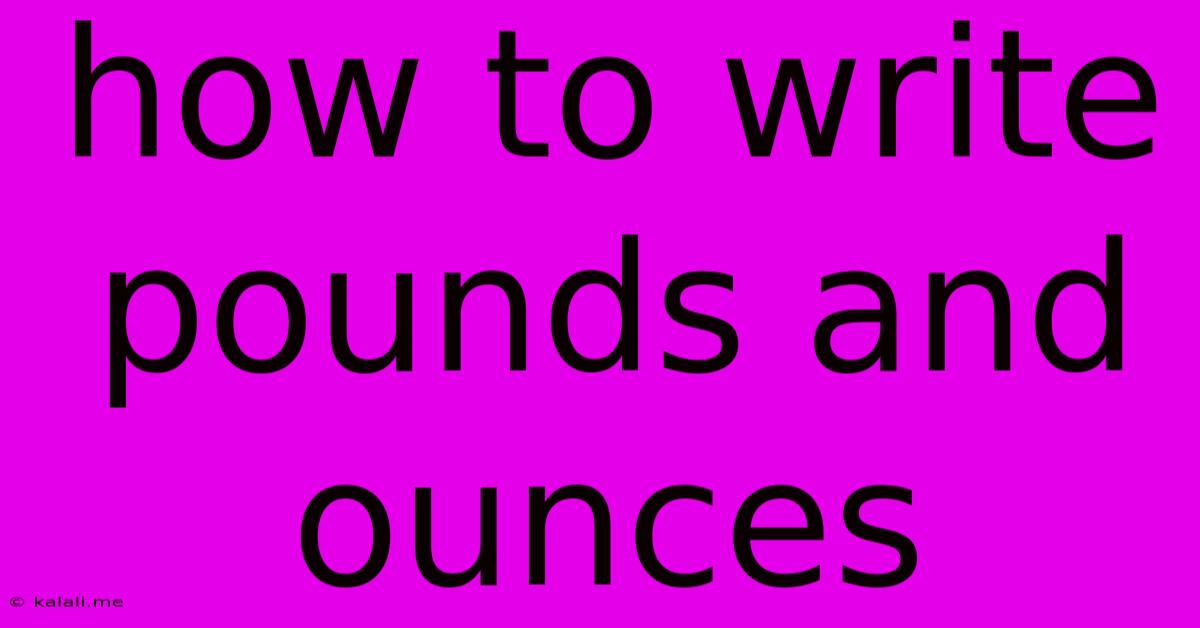How To Write Pounds And Ounces
Kalali
May 29, 2025 · 3 min read

Table of Contents
How to Write Pounds and Ounces: A Comprehensive Guide
Writing pounds and ounces correctly can seem straightforward, but there are nuances depending on the context and style guide you're following. This guide will cover various methods, ensuring your weight measurements are clear and consistent. This article will cover different formats, including abbreviations, using the correct punctuation, and when to use spaces. Understanding how to correctly write pounds and ounces is crucial for accuracy in various fields, from cooking and baking to shipping and manufacturing.
Understanding the Units
Before diving into the formatting, let's clarify the units:
- Pound (lb): A unit of weight in the imperial and US customary systems. It's approximately 0.45 kilograms.
- Ounce (oz): A unit of weight; there are 16 ounces in one pound.
Methods for Writing Pounds and Ounces:
Here are the most common ways to write pounds and ounces, along with their respective advantages and disadvantages:
1. Using Abbreviations:
This is the most common method. You use "lb" for pounds and "oz" for ounces.
-
Example: 5 lb 3 oz or 5lbs 3oz (Note: the use of 's' is optional).
-
Advantages: Concise and widely understood.
-
Disadvantages: Can be misinterpreted if not formatted clearly; requires careful spacing to avoid ambiguity.
2. Using the Word Form:
You can also spell out "pounds" and "ounces" in full.
-
Example: 5 pounds 3 ounces
-
Advantages: Clear and unambiguous, especially in informal contexts.
-
Disadvantages: Less concise than using abbreviations. This option might be preferred in certain types of writing, such as recipes or informal communications.
3. Decimal Representation:
For more precise measurements, particularly in scientific or technical contexts, expressing the weight as a decimal value of pounds is useful.
-
Example: 5.1875 lb (because 3 oz is 3/16 of a pound, which equals 0.1875)
-
Advantages: Precise and suitable for calculations.
-
Disadvantages: May not be as easily understood by a general audience. It requires more complex conversions and calculations compared to other writing styles.
Important Formatting Considerations:
-
Spacing: Always leave a space between the numerical value and the abbreviation or word. For example, use "5 lb" instead of "5lb". Consistent spacing improves readability.
-
Punctuation: Generally, you won't use commas or periods with these measurements unless part of a larger sentence. For example, "The package weighs 10 lb."
-
Consistency: Choose one method (abbreviations or full words) and stick to it throughout your document or communication to maintain consistency. This enhances readability and prevents confusion.
-
Context Matters: The best method depends on your audience and the purpose of your writing. For technical documents, decimal representation might be preferable. Recipes or informal notes may benefit from using the full words for pounds and ounces.
Examples in Different Contexts:
- Shipping Label: 2 lb 8 oz
- Recipe: 1 pound 4 ounces of flour
- Scientific Report: 3.5 lb
- Medical Record: 10 lbs 12 oz
By following these guidelines, you can ensure your weight measurements are clear, accurate, and easily understood by your audience. Remember to prioritize consistency and choose the method that best suits the context of your writing.
Latest Posts
Latest Posts
-
How To Dispose Of Butane Cans
May 31, 2025
-
Is It Ok To Boil Frozen Chicken
May 31, 2025
-
How To Replace A Shower Diverter
May 31, 2025
-
How To Get More Dwellers On Fallout Shelter
May 31, 2025
-
Changing Battery In Smoke Detector And Still Beeping
May 31, 2025
Related Post
Thank you for visiting our website which covers about How To Write Pounds And Ounces . We hope the information provided has been useful to you. Feel free to contact us if you have any questions or need further assistance. See you next time and don't miss to bookmark.